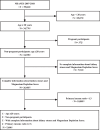Association between magnesium depletion score and the prevalence of kidney stones in the low primary income ratio: a cross-sectional study of NHANES 2007-2018
- PMID: 38874472
- PMCID: PMC11634088
- DOI: 10.1097/JS9.0000000000001822
Association between magnesium depletion score and the prevalence of kidney stones in the low primary income ratio: a cross-sectional study of NHANES 2007-2018
Abstract
Introduction: To explore the association between magnesium depletion score (MgDS) and the prevalence of kidney stones in the low primary income ratio (PIR).
Method: A cross-sectional study was conducted using data from the National Health and Nutrition Examination Survey 2007-2018. Within the low PIR, people aged ≥20 years with complete information on MgDS and kidney stones questionnaires were enrolled. Multivariable logistic regression and stratified logistic regression analyses were performed to examine the association between MgDS and the prevalence of kidney stones and the recurrence of kidney stones by confounding factors adjusted. Stratified and interaction analysis was conducted to find whether some factors modified the association. In addition, sensitive analyses were also conducted to observe the stability. The work has been reported in line with the strengthening the reporting of cohort, cross-sectional, and case-control studies in surgery (STROCSS) criteria (Supplemental Digital Content 1, http://links.lww.com/JS9/C781 ).
Result: A total of 7600 adults were involved in the study, and the individuals were classified into four groups: 0 points for MgDS ( n =3814), 1 point for MgDS ( n =2229), 2 points for MgDS ( n =1020), and ≥3 points for MgDS ( n =537). The multivariable logistic regression suggested that a positive association between MgDS and the prevalence of kidney stones (OR=1.123, 95% CI: 1.019-1.238) in the fully adjusted model. Compared with the lowest group, people with ≥3 points of MgDS had a significant relationship with kidney stones (OR=1.417, 95% CI: 1.013-1.983). No significant association was observed between the recurrence of kidney stones and MgDS. The result of the sensitive analysis showed the robustness of the main analysis.
Conclusion: The prevalence of kidney stones is positively correlated with MgDS, which suggests that maintaining a higher MgDS is accompanied by higher prevalence rates of kidney stones in the low PIR.
Copyright © 2024 The Author(s). Published by Wolters Kluwer Health, Inc.
Conflict of interest statement
All authors certify that they have no affiliations with or involvement in any organization or entity with any financial interest or non-financial interest in the subject matter or materials discussed in this manuscript.
Sponsorships or competing interests that may be relevant to content are disclosed at the end of this article.
Figures
References
MeSH terms
Substances
LinkOut - more resources
Full Text Sources


